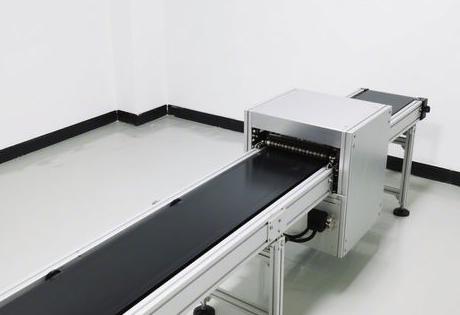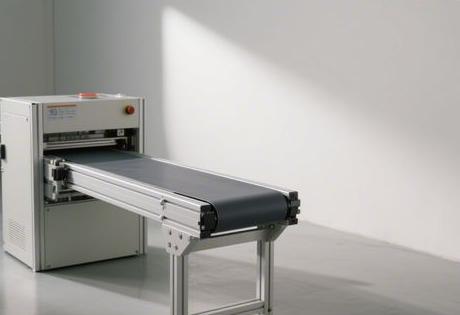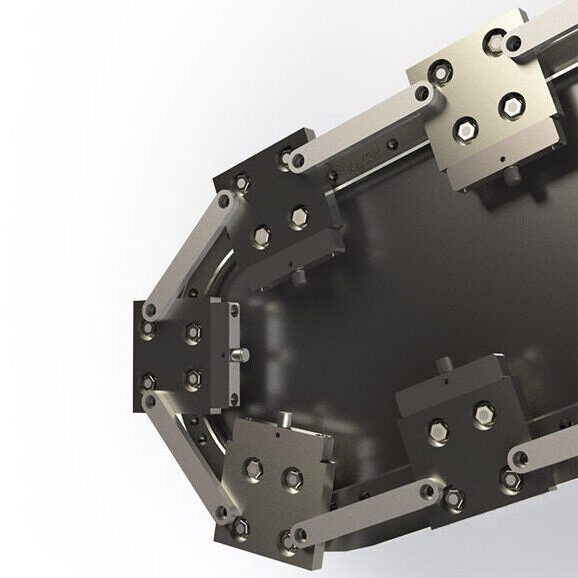I. Physical codes for light-duty doubling chains
The core value of the 50kg multiplier chain isOptimised design for speed increases for light loads. The formula for its work plate speed is:
Vₜ = V₁ × (1 + D/d)
When the roller diameter (D) is twice the roller diameter (d) (D=2d), the work plate speed can be up to three times the chain speed. This kind ofpassive incremental mechanism (PIM)No external energy source is required, but light-duty scenarios require two additional challenges to be addressed:

- Friction loss control: Nylon rollers (coefficient of friction 0.15) in conjunction with super-precision guides compress the actual growth rate attenuation to 95% of the theoretical value;
- Start-stop judder suppression: Acceleration is limited to 0.5m/s² to avoid deflection of lightweight workpieces.
Mechanical games for lightweighting
The rollers of the 50kg load chain are made ofHollow Composite Structure::
- POM engineering plastic matrix: Density only 1.4g/cm³, lighter than steel 78%, noise <60dB;
- Carbon fibre reinforcement: The local compressive strength is increased by 300%, and the deformation is ≤0.1mm after 3,000 starts and stops on average per day.
II. Structural design: a balancing act between lightweight and precision
Four-dimensional lightweight architecture
- Double row staggered roller set: 45° staggered layout spreads the load, increasing the single point load to 70kg;
- Pin micro-clearance control: DLC plating compresses the fit gap to 8μm, eliminating light-duty stalling;
- Magnetic tensioning system: Permanent magnet dynamically compensates for 0.1-0.5% chain elongation, 60% weight reduction over mechanical gravity hammers;
- Honeycomb Aluminium Chain Plate: Flexural stiffness 120GPa-mm⁴, weight 65% lighter than steel chain.
Space Flexibility Breakthrough
- Z-climbing layout: Maintains 2.8x speed on a 30° slope, with centrifugal force counteracting workpiece slippage;
- Modular quick release guides: Snap-on aluminium profiles for line restructuring in 10 minutes.
Material innovation: low noise and wear-resistant lightweight revolution
Nanoscale response to high-frequency scenarios
In the 3C electronic assembly line (5000 starts and stops per day), 50kg chain is used:
- Graphene reinforced nylon rollers: The coefficient of friction is reduced to 0.06, and the wear rate is only 1/7 of that of ordinary nylon;
- Titanium Memory Pins: Self-healing micro-deformation during temperature fluctuations, accuracy drift <5μm after 10,000 daily impacts.
Tackling Static Sensitive Environments
▶︎Anti-static Workwear Plate: Surface resistance 10⁶-10⁹Ω, dissipated static voltage <15V (HBM model);
▶︎Cleanroom Adaptation: Fully sealed rails + ionic air curtains, particulate release <100 pcs/m³ (ISO Class 5 standard).

IV. Intelligent control: a data-driven nerve centre
Dedicated control network for light duty
plaintextmake a copy ofSensing layer → Decision-making layer → Execution layer Laser displacement sensor (±0.01mm) → Edge computing AI model → Piezo-ceramic microbrake RFID reader (5ms response) → digital twin simulation → magnetic levitation damperPredictive Maintenance in Action
A mobile phone factory imported the solution:
- Acoustic analysis warns of roller cracks 72 hours in advance, with a false positive rate of <0.001‰;
- Adaptive adjustment of lubricant quantity, high temperature grease consumption reduced by 40%;
- Unplanned downtime reduced by 90% and MTBF (Mean Time Between Failure) exceeded 120,000 hours.
V. Application scenarios: from microelectronics to pharmaceutical packaging
Precision assembly of camera modules
- Workpiece size: Φ3mm lens, positioning needs to be ≤0.02mm;
- Capacity requirements: 200,000 pieces per day.
50kg Chain Breaking Programme::
- Air Flotation Plate: Compressed air membrane to isolate mechanical vibration, amplitude <10nm;
- Quantum Dot Antistatic Coating: Dissipation voltage <5V, yield improved to 99.99%.
High-speed dispensing of vaccine vials
▲Cyrin bottle conveying: 1000 bottles/minute, broken bottle rate <0.1‰;
▲ GMP certified material: 316L stainless steel chain plate, hypochlorite corrosion resistant.
Self-questioning: three questions about light-duty doubling chains
Q1: Why is it easier to achieve high speeds with light load chains?
Inertial constraint breakthrough::
- The moment of inertia of the workpiece under 50kg load is only 1/20 of that of heavy load, and the start-stop energy consumption is reduced by 75%;
- Optional D=3d design (theoretical 4 times speed), actual speed increase up to 3.6 times (heavy load only 2.5 times).
Q2:How to solve the positioning drift of light load workpiece?
(math.) a three-order stabilisation strategy::
① Piezo ceramic brake: response time 2ms, positioning error ±0.01mm;
② Machine vision deskew: 2000fps image closed-loop control;
③ Vacuum adsorption tooling: instantaneous adsorption force 150N, anti-vibration shift.
Q3: Is the cost of smart upgrades too high?
Lightweight IIoT solutions::
- Distributed sensors are used (unit price <50), the total cost of a single line is controlled atWithin 2000;
- An electronic factory test: input return cycle of only 8 months, troubleshooting efficiency by 90%.
When a 50kg speed multiplier chain is conveying vaccine vials in a class 10,000 cleanroom at a speed of 3.6x, its tooling plate is moving at a rate ofNanoscale stabilityCutting the boundaries between life sciences and precision manufacturing - behind this is theDeep synergy between lightweight materials and quantum level control. I think that lightly loaded multiplier chains will be the first to push the limits of the physical rate of increase: when theCarbon Nanotube RollerZero friction transmission is achieved whenphotonic sensorBy analysing vibrations at the molecular level in real time, the ultimate goal of conveying efficiency is no longer "speed doubling", but ratherReconstructing the Determinism of Matter Motion on the Picometer Scale. And the low-frequency resonance of the nylon rollers and aluminium rails at this moment is a quantum symphony of micro-manufacturing paying homage to macro-efficiency.













